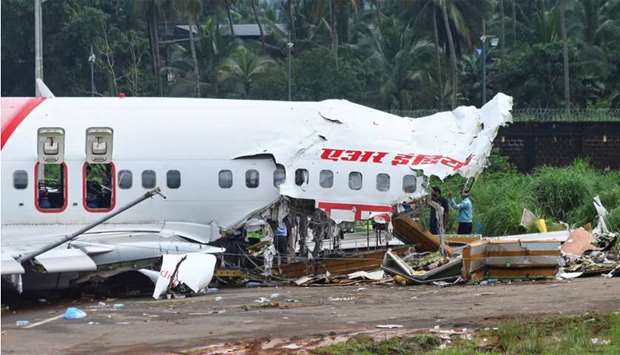The Air India Express plane, which was repatriating Indians stranded in Dubai due to the coronavirus pandemic, overshot the runway of the Calicut International Airport in Kerala in heavy rain on Friday.
The aircraft fell into a valley and broke in half.
Arun Kumar, head of then Directorate General of Civil Aviation, said yesterday the country would open the recovered transcripts to international investigators, as well as manufacturer Boeing.
“Only after conducting a thorough and unbiased probe, can we tell what exactly happened,” Kumar said.
The 2,700m runway at the airport is known as a “table-top”, an aviation term for runways with steep drops at one or both ends.
They leave little room for error should a pilot overshoot the runway, either through human error or mechanical failure.
Late on Saturday, Kumar told CNN-News18 in an interview that the pilot made an aborted landing attempt into a headwind and then made a second approach with a tail wind, landing 1,000m down the runway.
An air traffic control official familiar with the crash confirmed this version of events, adding it is unusual to attempt a landing at the airport with a tailwind, which is typically used for takeoffs.
“The length of the runway in Calicut is around 2,700m and the plane touched the ground after crossing 1,000m of the length, leaving less room to bring the aircraft to a halt,” the official, who declined to be named as he is not authorised to speak to the media, said.
“It was windy and rainy and the runway surface was wet. In such instances the weather is dynamic.
“An aircraft typically lands and departs in a headwind as a tailwind increases the plane’s speed.”
A spokesman for Air India did not immediately respond to a request for comment.
The company has already said it will pay compensation to the families of the deceased.
Civil Aviation Minister Hardeep Singh Puri on Saturday said that several issues about the airport which were red flagged by the DGCA were addressed by the airport operator.
These issues pertain to excessive rubber deposits, water stagnation and cracks, among others.
In a series of tweets, Puri said that raising such concerns is the normal work of DGCA.
Besides, he said the aviation regulator strictly ensures that these issues are rectified under all circumstances and this was done by the airport operator.
“I would like to remind my colleagues that the aircraft involved in the incident at Kozhikode was a B-737-800 which is NOT a wide body aircraft. As far as wide body aircraft are concerned, DGCA had carried out a thorough assessment & prescribed comprehensive mitigation measures.”
The minister was responding to a tweet that a ban on wide body aircraft landing was removed in 2019.
He said the Airports Authority of India strengthened the runway and thereafter necessary permissions were issued in 2018 to operate wide body aircraft.
Consequently, certain carriers started operating some flights with wide body aircraft to Kozhikode airport.



